- News
- Reviews
- Bikes
- Components
- Bar tape & grips
- Bottom brackets
- Brake & gear cables
- Brake & STI levers
- Brake pads & spares
- Brakes
- Cassettes & freewheels
- Chains
- Chainsets & chainrings
- Derailleurs - front
- Derailleurs - rear
- Forks
- Gear levers & shifters
- Groupsets
- Handlebars & extensions
- Headsets
- Hubs
- Inner tubes
- Pedals
- Quick releases & skewers
- Saddles
- Seatposts
- Stems
- Wheels
- Tyres
- Tubeless valves
- Accessories
- Accessories - misc
- Computer mounts
- Bags
- Bar ends
- Bike bags & cases
- Bottle cages
- Bottles
- Cameras
- Car racks
- Child seats
- Computers
- Glasses
- GPS units
- Helmets
- Lights - front
- Lights - rear
- Lights - sets
- Locks
- Mirrors
- Mudguards
- Racks
- Pumps & CO2 inflators
- Puncture kits
- Reflectives
- Smart watches
- Stands and racks
- Trailers
- Clothing
- Health, fitness and nutrition
- Tools and workshop
- Miscellaneous
- Buyers Guides
- Features
- Forum
- Recommends
- Podcast
£1,300.00
VERDICT:
Really good multi-purpose road disc bike that's well-specced and comfortable
Weight:
10,460g
Contact:
www.evanscycles.com/products/fuji/sportif-11-le-2015-road-bike-ec108532
At road.cc every product is thoroughly tested for as long as it takes to get a proper insight into how well it works. Our reviewers are experienced cyclists that we trust to be objective. While we strive to ensure that opinions expressed are backed up by facts, reviews are by their nature an informed opinion, not a definitive verdict. We don't intentionally try to break anything (except locks) but we do try to look for weak points in any design. The overall score is not just an average of the other scores: it reflects both a product's function and value – with value determined by how a product compares with items of similar spec, quality, and price.
What the road.cc scores meanGood scores are more common than bad, because fortunately good products are more common than bad.
- Exceptional
- Excellent
- Very Good
- Good
- Quite good
- Average
- Not so good
- Poor
- Bad
- Appalling
The Fuji Sportif 1.1LE is an excellent bike. It offers a comfortable, assured ride that comes from a dependable frame and fork and a well-considered equipment package that manages to squeeze in Shimano's excellent hydraulic discs for £1,300 without any major compromises elsewhere. If you're looking for a reasonably quick but solid and reliable road bike this will tick a lot of boxes for a lot of people.
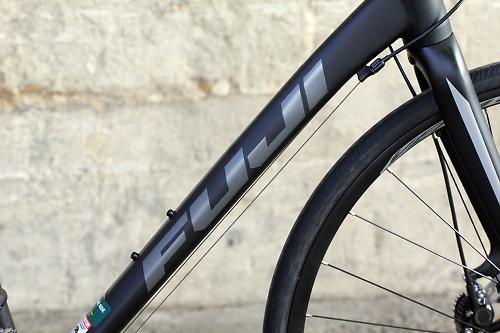
Fuji have been making their alloy Sportif for a number of years; for 2015 the range splits into disc and non-disc models. This limited edition bike (don't worry, not that limited) is a UK-specific build that's been specced by Evans Cycles. It shares its hydroformed, double-butted frame as the rest of the Sportif range. The bottom bracket is a BB86 press-fit and the headset is the asymmetric 1 1/8in - 1 1/2in that's become more or less the norm. That means there's plenty of welding space at the bottom bracket and head tube and Fuji make good use of that, with big tube profiles designed to give a stiff backbone to the bike.
The fork has carbon blades and an alloy crown and steerer. It's a cyclocross-length fork which, coupled with the tall head tube (21cm on our 58cm test bike) makes for a fairly upright position. There's 30mm of spacers to play with, but you're unlikely to need them; I like a relaxed position on a bike like this, and I've got the stem slammed right down.

The top tube has a fairly pronounced slope which means that you'll run a bit more seatpost, and it's a 27.2mm wide for a bit more give at the back. I'm fairly tall (1.89m) but although the 58cm bike is the right size for me the seatpost wasn't long enough to get my saddle height and I had to swap it out, which was a bit of a faff. Also, the rather skeletal seatpost clamp feels a bit under-engineered for the job, I'd rather see a solid band than the machined one you get, pretty as it is.
Once that was sorted it was time to head out and knock out some miles. And from the off, I was impressed with the Sportif. I tested the non-disc version back in 2013 and found it a good all-rounder, but with a bit of flex in the frame. This updated bike is noticeably better in that regard. The bigger tube profiles and chunky bottom bracket mean that stamping on the pedals elicits very little movement, except for forwards. The fork is much better, too. It tracks very well and has no problem coping with the braking forces from the disc. Out of the saddle there's very little disc rub either.
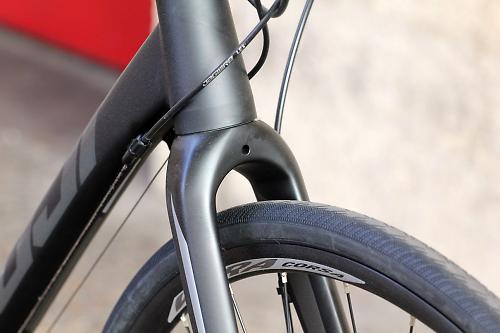
It's a comfortable bike, both because of the position and because the 28mm tyres and decent bar tape and saddle take a lot of sting out of the ride. The frame itself is pretty stiff but not harsh but that's tempered by the component choices and the end result is a bike that's easy to ride for hours at a time. And although it's not especially light, and not especially aerodynamic, it's no slowcoach.
Okay you don't want to spend too many hours trying to keep up with your friends of similar fitness on their SuperSix Evos (I know, I've tried) but it's good for big rides at a decent pace. I've done six hours on the Sportif down to the Devon coast (and back again two days later) and I've nothing bad to say about the ride. The bike is neutral in temperament, great for cruising and predictable at speed. It can be a touch ponderous when you're going slowly. But mostly you won't be.

There are mounting points front and rear if you want to fit mudguards, and I did, squeezing them in around the 28mm Vittoria Zaffiro tyres. That's probably your limit with 'guards; without them the frame will probably accommodate a 32mm at a push. There's lots of room in the fork. It's not a bike that's designed for off-road excursions but it's happy enough on unsurfaced fire roads and towpaths, even with the tyres it comes with.
The brakes are excellent. The will-the-pros-or-won't-they debate can run and run (until 2017, at least) but the Shimano R685 brakes are more or less the best you'll get on a road bike right now. They're massively confidence-inspiring on twisty, steep descents (we have a lot of those round here) where it's easy to scrub off a bit of speed without having to grab a handful of brake. They're easy to use and predictable. For the type of riding this bike is designed for, they're perfect.
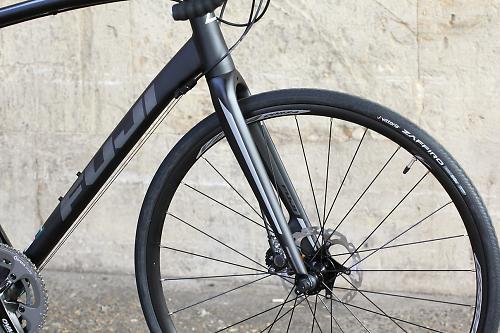
The wheels those discs are bolted to are Vera rims and Formula hubs, a combination that's best described as dependable. There's nothing wrong with them, although they do blunt the acceleration of the bike along with the fairly weighty tyres. Once they're rolling they do a grand job. At some point in the future you might want to swap them out for something more lively, but it won't be because they're broken.
The other benefit of the R685 brakes is that you're effectively getting Ultegra-level shifting on the Sportif. The derailleurs are Shimano 105 but the lever feel (and the carbon brake levers) are more like the second-tier groupset. The R685 levers will only do two upshifts at a time instead of three, but that's the only compromise.
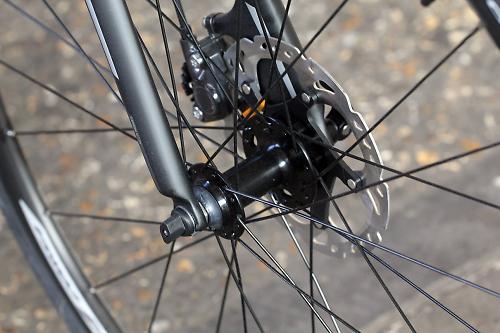
A mid-cage rear mech gives the opportunity to fit an 11-32 cassette for the widest possible spread of gears. You don't get a Shimano chainset but you do get an Oval one with 50/34 Praxis rings, which is probably better than the Shimano non-series one anyway and certainly an improvement on the lower-grade FSA units that you often get on a bike like this that's being built to a tight budget.
Oval stem, bars and (not long enough) seatpost complete the build, along with an Oval-branded Velo saddle that's quite Charge-Spoon-like in its shape and comfort, and Oval suede bar tape.
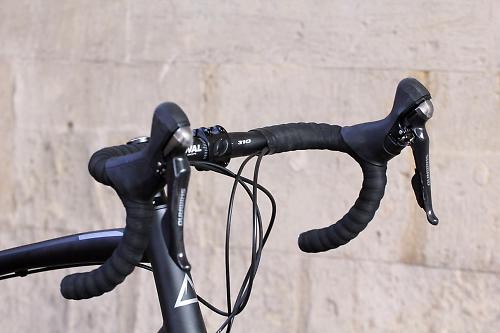
It's really pleasing to get a bike that feels so well thought through, and is also so enjoyable to ride. You could easily knock out a sportive on this Fuji, or just bung some mudguards and a rack on it and ride it to work, or use it as a training bike through the winter. You could pilot it on increasingly lengthy Audax rides (I considered doing an upcoming 300km on it and I've no doubt it would have handled it without any issues), or you could fill your panniers and head off for a week's touring. The Sportif would cope very well with any of those, or all of them with minimal equipment changes. Its versatility is a big plus.
If the £1,300 price tag is a bit salty for you then the £950 1.1D build has a more-or-less identical spec with the exception of the brakes, which are Avid BB7s controlled by 105 levers. That's a fairly hefty premium: not far off what you'd pay for buying the levers and fitting them yourself, which is a sticking point so far as value is concerned. That's not to say the bike overall doesn't represent good value – it does – but the price tag of the mechanical bike takes the shine off what is otherwise a really good offering from Fuji.

Verdict
Really good multi-purpose road disc bike that's well-specced and comfortable
road.cc test report
Make and model: Fuji Sportif 1.1 Ltd
Size tested: Black, Size : 58 cm
About the bike
State the frame and fork material and method of construction. List the components used to build up the bike.
Frame:
A2-SL compact double-butted alloy w/ hydroformed top tube & down tube, integrated 1 1/2" lower head tube & PIIS BB86 shell, double water bottle mounts, rear triangle A2-SL alloy tapered seatstays/chainstays w/ rack mount, forged-road disc dropout w/ 1 eyelet and replaceable derailleur hanger
Fork:
FC-770 Cross carbon blade, alloy crown w/ tapered alloy steerer & alloy dropout
Front Derailleur:
Shimano 105
Rear Derailleur:
Shimano 105, 11-speed
Number of Gears:
22
Shifters:
Shimano 105, STI, 11-speed
Chainset:
Oval Concepts 520, forged 6066 arms
Chainrings:
50/34T
Bottom Bracket:
Oval Concepts, BB86 press-fit
Cassette:
Shimano 105, 11-32T, 11-speed
Chain:
KMC X11, 11-speed
Pedals:
Not Supplied
Brakeset:
Shimano R685, 160mm / 140mm rotors
Handlebars:
Oval Concepts 310, butted 6061 alloy, 31.8mm
Stem:
Oval Concepts 313, 6061 3D-forged alloy, 31.8mm, +/- 7 degrees
Headset:
FSA, 1 1/8"? upper – 1 1/2"? lower, integrated
Grips:
Oval Concepts 300, padded suede
Rims:
Vera Corsa DPD22, double wal
Front Hub:
Formula disc
Rear Hub:
Formula disc
Front Tyre:
Vittoria Zaffiro, 700 �– 28, 30tpi
Rear Tyre:
Vittoria Zaffiro, 700 �– 28, 30tpi
Saddle:
Oval Concepts R300 w/ steel rails
Seatpost:
Oval Concepts 300, 3D-forged 6061 alloy, 27.2mm, double-bolt micro-adjust
Tell us what the bike is for, and who it's aimed at. What do the manufacturers say about it? How does that compare to your own feelings about the bike?
Riders looking for their first road bike to explore miles of country roads or who even see racing in their future, we introduce the Fuji Sportif LE 2015 Road Bike, A2-SL double-butted aluminium tubing, carbon fork, and wheels from in-house brand Vera achieve the perfect balance of comfort, quality, and value. New for this Year, Evans Cycles have worked exclusively with Fuji on this special hydraulic disc option for 2015. Using Shimano's RS685 STI levers, the brakes offer great modulation and incredible stopping power at your fingertips. Integrated shifting from Shimano ensures riders remain in control when shifting gears on the most challenging roads, and the 28mm Vittoria tyres provide a comfortable and smotth riding experience.
Frame and fork
Overall rating for frame and fork
8/10
Tell us about the build quality and finish of the frame and fork?
Nicely put together, tidy welds.
Tell us about the materials used in the frame and fork?
Frame:
A2-SL compact double-butted alloy w/ hydroformed top tube & down tube, integrated 1 1/2" lower head tube & PIIS BB86 shell, double water bottle mounts, rear triangle A2-SL alloy tapered seatstays/chainstays w/ rack mount, forged-road disc dropout w/ 1 eyelet and replaceable derailleur hanger
Fork:
FC-770 Cross carbon blade, alloy crown w/ tapered alloy steerer & alloy dropout
Front Derailleur:
How was the bike in terms of height and reach? How did it compare to other bikes of the same stated size?
Fine, apart from the problems with the seatpost.
Riding the bike
Was the bike comfortable to ride? Tell us how you felt about the ride quality.
Very comfortable.
Did the bike feel stiff in the right places? Did any part of the bike feel too stiff or too flexible?
Frame is stiff, fork tracks well.
How did the bike transfer power? Did it feel efficient?
Power transfer is good, wheels blunt acceleration a bit.
Was there any toe-clip overlap with the front wheel? If so, was it a problem?
Not without mudguards.
How would you describe the steering? Was it lively, neutral or unresponsive? Neutral to slow.
Tell us some more about the handling. How did the bike feel overall? Did it do particular things well or badly?
It's a bike that at its best at cruising speed, although it's predictable at speed too.
Which components had the most effect (good or bad) on the bike's comfort? would you recommend any changes?
Tyres, saddle and grips take a lot of sting out of the ride.
Which components had the most effect (good or bad) on the bike's stiffness? would you recommend any changes?
All good in terms of stiffness.
Which components had the most effect (good or bad) on the bike's efficiency? would you recommend any changes?
Wheels and tyres slow things down a bit.
Rate the bike for efficiency of power transfer:
8/10
Rate the bike for acceleration:
7/10
Rate the bike for sprinting:
5/10
Rate the bike for high speed stability:
8/10
Rate the bike for cruising speed stability:
10/10
Rate the bike for low speed stability:
7/10
Rate the bike for flat cornering:
8/10
Rate the bike for cornering on descents:
8/10
Rate the bike for climbing:
7/10
The drivetrain
Rate the drivetrain for performance:
9/10
Rate the drivetrain for durability:
8/10
Rate the drivetrain for weight:
7/10
Rate the drivetrain for value:
8/10
Wheels and tyres
Rate the wheels and tyres for performance:
7/10
Rate the wheels and tyres for durability:
9/10
Rate the wheels and tyres for weight:
5/10
Rate the wheels and tyres for comfort:
8/10
Rate the wheels and tyres for value:
7/10
Controls
Rate the controls for performance:
8/10
Rate the controls for durability:
8/10
Rate the controls for weight:
7/10
Rate the controls for comfort:
8/10
Rate the controls for value:
7/10
Your summary
Did you enjoy riding the bike? Yes.
Would you consider buying the bike? Yes.
Would you recommend the bike to a friend? Yes.
Rate the bike overall for performance:
8/10
Rate the bike overall for value:
7/10
Anything further to say about the bike in conclusion?
The £950 1.1D looks better value but the hydraulic discs are a highlight and it's not overpriced for the build.
About the tester
Age: 42 Height: 189cm Weight: 91kg
I usually ride: whatever I'm testing... My best bike is: Kinesis Tripster ATR
I've been riding for: Over 20 years I ride: Every day I would class myself as: Experienced
I regularly do the following types of riding: road racing, commuting, club rides, sportives, general fitness riding, fixed/singlespeed, mtb, Mountain Bike Bog Snorkelling, track
Dave is a founding father of road.cc, having previously worked on Cycling Plus and What Mountain Bike magazines back in the day. He also writes about e-bikes for our sister publication ebiketips. He's won three mountain bike bog snorkelling World Championships, and races at the back of the third cats.
Latest Comments
- wtjs 9 min 4 sec ago
The likes of Facebook, Instagram have done untold damage, especially to the minds of young people...
- chrisonabike 17 min 28 sec ago
And the next time - plead sympathy for your addiction, caused by trauma from your previous "accident"...
- wtjs 20 min 43 sec ago
Butyric Acid... was the most disgusting thing I have ever smelt in the lab...
- chrisonabike 20 min 34 sec ago
You'll find that every society makes overt and covert rules about what is "need" vs. "want" vs. "thou shalt not" - which is not entirely linked to...
- ubercurmudgeon 51 min 39 sec ago
Even a stopped clock, etc, etc...
- Bigtwin 2 hours 12 min ago
I wouldn't be meeting that Orange Pillock anywhere, let alone 1/2 way.
- Laz 2 hours 28 min ago
If the local police is unwilling or unable to do their job properly, then perhaps her insurance provider ought to re-evaluate the risks she poses...
- Martin1857 13 hours 22 min ago
As a member of the Co-op community (I live in a Housing Co-op) and a bike owner /rider, this is very sad news. We need more Co-ops not less.
- Dnnnnnn 13 hours 13 min ago
It is sad for the individuals concerned but (and this is a general point, rather than specific to this story), we're much better off overall for...
- David9694 14 hours 9 min ago
Lorry carrying 25 tonnes of beer catches fire on the M11...




































Add new comment
9 comments
I got the 1.1D several days ago, with BB7 brake.
Quite comfort and works great as a commuter bike.
But I still want to upgrade it to be lighter.(If possible without upgrading frameset).
So what should be upgraded first? Wheels? Or finishing kits?
Or, don't waste money and time and just use it as a commuter bike?
Or you can get a £2100 Norco Search Ultegra, with 685's. Not £1.4k, but it's a lovely gravel bike. Has 'guard mounts too.
So if the BB7/105 model was £1100, this would look good value?
All this does is convince me that what I actually want is a Canyon Endurace with the hydraulics.
Let me get this right:
Full hydraulics
Ultegra-level shifting
105 bits
Good-enough rings
Ability to mount mudguards
For £1300.
...isn't that first digit supposed to be a 2?
Wow.
It'd need to weigh about 1.5kg-2kg less to have a two at the start or the price!
Mike, three words. Jamis Renegade Expert. All of those things plus a carbon frame. And currently on sale for less in the UK than it is in the USA, where Jamis is from.
We're testing the posher £2.5k version and it's a belter.
OOooh crikey. That does look nice. The only whine from me would be the external brake hose on the fork.
But the Evans one is £1400 with HyRd's? The elite is £2.5 with the 685's...
that £2.5k gets you a bike that's 8.7kg instead of 10.5kg though. it has the same brakes but everything else is at least one rung up the ladder...
that's 8.7kg with big tyres on, as well
Oh yeah I forgot about the downgrade on the £1400 model. Soz